Revision: 5.7
Date: 12.03.2004. |
This
project is published
in magazine InfoElektronika
#59 |
 |
This device is constructed
for IR REMOTE Controll of LIght Bulbs, with two independent
chaNnels (bulbs), and for remote controller can be
usead any Philips RC5 device from TV, VCR or audio...
Button
functions on RC5 remote controll for IRPS01 device
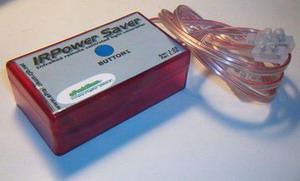
Picture of device IRPS01
|
This device's
mott is contradictory a little bit: "it should
be simple, but very powerful". It uses all
privileges of modern microcontrollers: small power
consumption, small pin count, internal RC oscillator...
The device that we present is a bit of deja-vu,
but it is done in completely new way. It can also
be upgraded with just a little bit of imagination...
It regulates light in your house in sipliest way,
with only one button on itself and with a remote
controller. Let your light bulbs last longer and
extend your comfort by using this device for soft
remote turning-on/off of them. |
Supply
voltage: ~80V-240V AC
/ 50Hz
Command: Taster TS1 on device case, or
(Philips) RC5 remote controller
Number of channels: it is possible
to connect two light bulbs up to 100W and control
them independantly
Light bulbs threatment: soft turning on/off
(SOFT - Start, SOFT – Down) !!!
Special comfort:
Sleep timer for 1-9min
Output power by channel: in basic version
- 150W; with some adjustments - up to few kW
(!)
Very high modularity and flexibility, thanx to
the software in microcontroller itself, so that
new functions can be implemented.
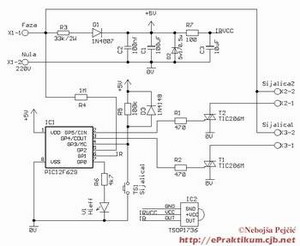
Picture 1
- Electrical SCHematic |
For details please click on
picture, or on this link bitmap |
Device description:
Dimmer
that we present here has some of this attributes:
-
simple
- reliable
- functional
- saves
power
- inteligent
Lets
present hardware first:
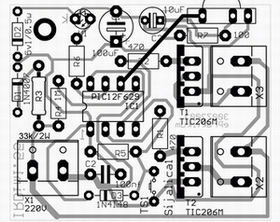 |
Picture 2
- PCB for IRPS01 device
(Download a zip archive) |
We tried to use maximum of hardware and software
and, as long as physics let us, to apply all of our
experience so that we could acheive high quality of
this device. After few months of developing and testing,
we present you the IRPS01 device.
Device's hardware
is very simple. Heart of the system is Flash microcontroller
PIC12F629, which costs very low, about a few euros.
We already wrote about it's characteristics, so we
wont get into that now. For additional informations
you should visit www.microchip.com.
Principle of regulation:
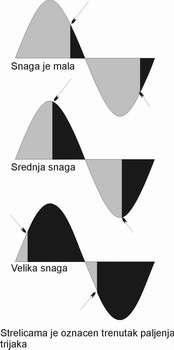 |
Phase
regulation is applied here, using triacs as output
drivers. Regulation graphics and principles are
shown on picture 2.
Taster is used for setting
one of the bulbs. Infra-red (IR) receiver we
used is hybrid SFH506 realised by company Vishay
by the name TSOP1736. Led diode V1 shows certain
states of regulator and indicates receiving
of infra-red signal from remote controller.
Detection of zerocrossing is done by single
resistor of 1Mohm. Device's power supply is
the simpliest possible and is managed by elements
R3, D1, D2, C1 and C2. Resistor's (R3) function
is to limit electrical current through zenner-diode
(D2), which stabilizes voltage at 5V. Diode
D1 is used for half-wave rectification of alternating
voltage, while condenser C2 and electrolite
condenser C1 are doing final filtration of rectified
voltage. As this power supply gives the most
optimal relation between heating of resistor
R3 and current which is provided by this supply,
it is very important to use exact values for
elements shown on schematics. Oscillator, whic
is necessary for working of microcontroller,
is also present, but it is implemented in small
microcontroller's structure.
|
Picture
2 - Phase regulation |
|
Zerocrossing detector:
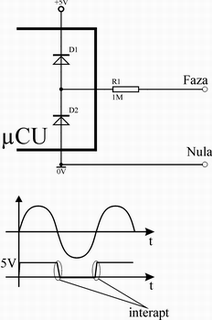 |
Interesting
part of hardware is, of course, ZC (zerocrossing)
detector. It is managed by single resistor (R4).
Yet, its basic function is to limit current
which is going in microcontroller. There are
'clamping' diodes inside the microcontroller
on almost every pin, which lead overvoltage
peaks to supply so that they could not damage
the microcontroller. We used them to convert
sinusoidal alternating voltage into quazi-square
voltage so that we can generate interrupt signals
on every falling/rising edge of this voltage.
Because
this diodes are low current, resistor of 1M
ohms limits current to value of about hundred
µA so that we can prevent destruction of device.
Interrupt routine is processed at every zerocrossing.
Graphic illustration of this principle is shown
on picture 3.
|
| Picture 3
- Zero cross detection |
|
Triac
driving:
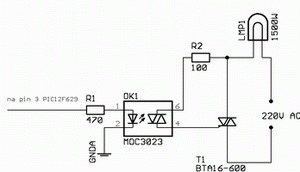
Picture 4 -
possible improvement for driving of stronger
consuming devices (1500W) |
Major problem in developing
this device was current for triac driving.
Because power supply for this device is designed
with resistor, supply current that we are
handling is about a few mA. If we tried to
drive triac with long-duration signals, current
consumption would be exceeded. That is the
reason why the triac is fired with short-duration
signals (app. 20 µs). This duration is enough
for correct firing of triac when there is
enough voltage on its pins (A1 and A2). Nature
of triac functioning enables auto-off when
voltage is zerocrossing. This principle demands
usage of triac with sensitive gate (5mA),
as, for example, TIC206M, or TIC216M. Possible
way to improve driving capacity is to change
existing output stage with circuit shown on
picture 4. This way enables usage of high
current gate triacs (for example, BTA16-600).
This way we successfully drove 1600W quartz
heater.
|
Firmware:
Everything that we avoided in hardware
design on purpose, we compensated in microcontroller's
firmware. It developed into complex firmware with
lot of options. We will explain them shortly. Basic
characteristic which we woud like to highlight is
presence of soft-start algorhythm. When user initiate
turning on/off of light bulb, it drives in more than
hundred steps from zero to full voltage. In that way
we acheived gradual heating of light bulb, so it should
last much longer.
In addition, we
installed principle of inteligent zerocrossing detection,
that reduces fake triac firing, which approved device
stability. This method, with addition of serial choke
of 220uH, successfully removes all potential interruptions
made by electrical drill connected parallel to same
electrical plug with this regulator.
Remote control
protocol that we embedded is popular biphase RC5.
It is common with most of remote controllers. This
protocol was developed by Philips. This way we avoided
making of our remote controller. Device also has a
sleep timer, which enables automatic turning off of
both light bulbs after time that was set by user (1-9min).
One button on remote control provides locking of IRPS01
device, so that other remote controllers can be used
in the same room.
If there is no
remote controller near by, you can regulate one light
bulb with button (TS1) on device's case. Short press
- soft turning on/off of light bulb; longer press
- continual regulation from minimum to maximum, and
vice versa.
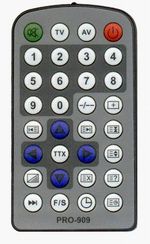 |
LED indicator,
with RC5 code receiving, blinks in the rhythm
of receiving sequence. This is useful when checking
if remote controller is in function, and if
RC5 compatible. If sleep timer is ON, LED indicator
will blink every second. If the device is locked,
LED indicator lights continually. You can find
complete functions of buttons on RC5 remote
controller for this device on this link.
|
Making the device:
PCB dimensions are 43x36 mm. It
has all components included, except the choke, which
could not fit into PCB. It has 220uH, nominal current
3A, and it was the best tested in practical use. This
device can be tested without it, but it it neccessary
for suppressing voltage disturbances in main electrical
supply which is generated by phase regulation (for
example, hum in radio devices).
| Choke that was used
in prototype (220uH/3000mA) |
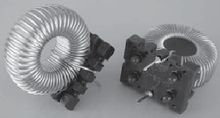 |
Microcontroller
needs to be putted last on PCB.
NOTE: PIC12F629
has to be programmed with appropriate firmware before
putting on PCB. Firmware is not freeware. If you are
interested, you can contact us.
It is recommended
to build fuse of 2A in, for safety reasons. At the
end you should check all of the connection one more
time, because all of components can be destroyed by
single error in connections. Don't forget the only
short-cutter which connects microcontroller's pin
6 with TSOP1736 hybrid.
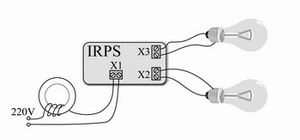 |
Picture 6
- Principle of connecting light bulbs and main
supply to IRPS01 device |
NOTE:
Device is not galvanically isolated from main supply,
and can be dangerous! It should have good isolation
from direct touch.
For the
end:
Device that we
described here hasn't been exploited yet. It was tested
in a few places, and prototype still works in my home
more than 3 years. Possibilities of this device are
very high, and it is still under upgrading phase.
For all unclearances and questions you can contact
us.
Firmware is not
freeware and, if you are interested in ordering HEX
or source file, you can contact us at this adress:
npejcic@epraktikum.iz.rs










